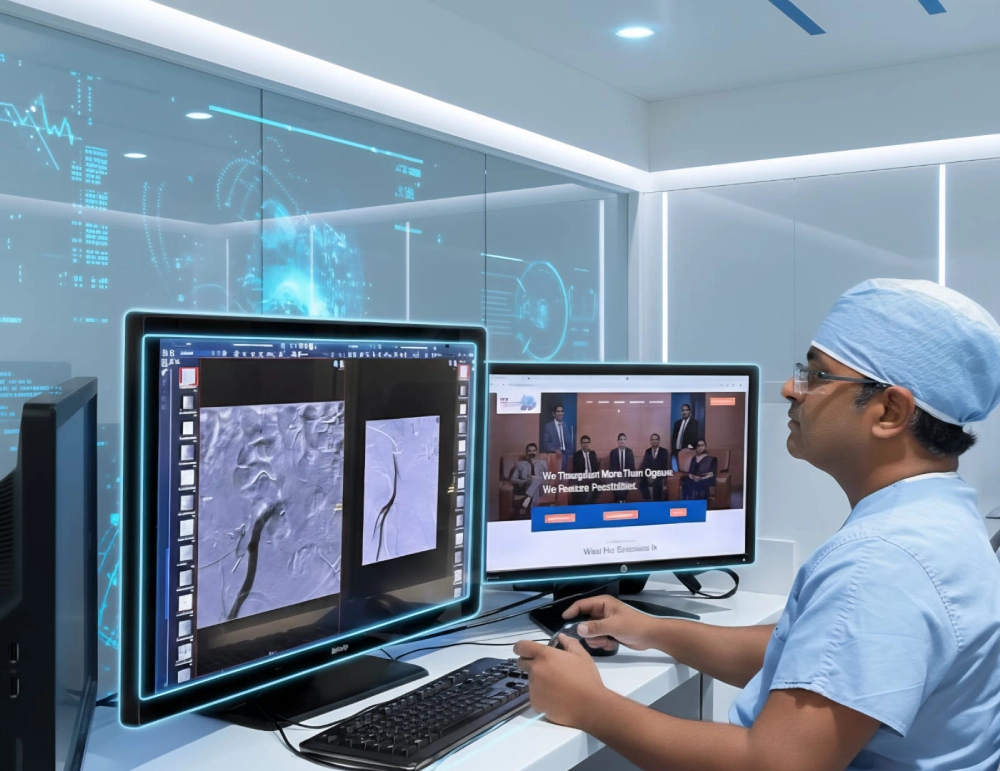Interventional Radiology (IR)
“Precision Medicine. Minimally Invasive. Maximum Impact.”
Madras Transplant Associates, Unit of CareVue Health, is at the forefront of Interventional Radiology (IR), a transformative field that uses cutting-edge imaging technology to deliver minimally invasive, precise, and highly effective treatments for a variety of medical conditions. With a commitment to innovation and patient-centered care, CareVue Health’s Interventional Radiology Program is revolutionizing how diseases are diagnosed and treated.

What is Interventional Radiology (IR)?
Interventional Radiology (IR) uses cutting-edge imaging technology, medical accuracy, and expert staff to offer minimally invasive treatment options for a wide range of illnesses. The techniques used are meant to treat a wide variety of diseases for maximum success with minimal access and perhaps, eliminating the need for traditional surgery.
Think of Interventional radiology, whether you have been diagnosed with cancer, have chronic pain, or are looking for an alternative to surgery.
Depending on the underlying condition to be treated, using real-time imaging, Interventional radiologists can:
- Navigate to any part of the body using tiny catheters and wires.
- Manage the problem: such as blocking blood flow to Tumors, shrinking fibroids, opening blocked vessels, or draining infected collections, etc.
- Minimal damage to the surrounding healthy tissues by using precision imaging and specialized tools
Important Benefits of IR Methods
- Minimal access; Maximum results
- Less risk — Infection, bleeding, and problems are less likely to occur.
- Convenient - Several procedures on the same day
- Quick Recovery — Less recovery time
- Most are done with minimal sedation, avoiding risks from anesthesia
IR is the intersection of technology and healing, allowing for a more complete and effective recovery for patients.
Tumor Ablation Therapies
What it is:
Minimally invasive treatments such as Radiofrequency Ablation (RFA), Microwave Ablation (MWA), and Cryoablation use heat or extreme cold to destroy tumors, guided by CT or ultrasound.
- When to consider referring:
- Small liver tumors (HCC, metastases) in patients not eligible for surgery
- Kidney tumors where nephron-sparing is preferred
- Isolated lung or bone metastases
- Benefits to patients:
- Outpatient or short-stay procedure
- Organ preservation and minimal functional loss
- Repeatable if new lesions develop
Chemoembolization (TACE) & Radioembolization (TARE)
- What it is:
- TACE delivers chemotherapy directly to the tumor’s blood supply, followed by embolization to cut off blood flow.
- TARE delivers tiny radioactive beads (Y-90) to irradiate tumors from within.
- When to consider referring:
- Intermediate or unresectable liver cancers
- Hypervascular metastases (e.g., neuroendocrine tumors)
- Cases not responding to systemic therapy
- Benefits to patients:
- Targets the tumor directly, limiting systemic side effects
- Can be combined with systemic therapies
- May downstage patients to surgery or transplant
Interventional Radio-Oncology
- What it is:
- Collaboration between Interventional Radiology and oncology teams to offer localized tumor control alongside systemic treatments.
- When to consider referring:
- Definitive therapies in early stages of cancer, which can be curative or downstaging
- Patients needing symptom relief (pain, bleeding, obstruction)
- Patients unsuitable for surgery but still needing local tumor control
- Benefits to patients:
- Organ preservation
- Symptom control and improved quality of life
- Multidisciplinary approach for best outcomes
Vascular Interventions
- Angioplasty & Stenting
- Restores blood flow in blocked arteries (e.g., PAD, renal artery stenosis)
- Reduces symptoms such as claudication or uncontrolled hypertension
- Embolization
- Stops bleeding (e.g., postpartum hemorrhage, trauma)
- Shrinks symptomatic tumors (e.g., fibroids)
- Treats vascular malformations
- DVT & PE Management
- Catheter-directed therapy to remove or dissolve clots
- Reduces long-term complications like post-thrombotic syndrome
Portal Hypertension — TIPS
- What it is:
- Creates a channel within the liver to reduce portal pressure.
- When to consider referring
- Variceal bleeding not controlled with endoscopy
- Refractory ascites or hepatic hydrothorax
- Benefits to patients
- Prevents recurrent bleeding
- Improves ascites control when medications fail
Renal Interventions
- Renal artery angioplasty ± stenting – for renal artery stenosis (atherosclerosis, fibromuscular dysplasia, Renal Transplant)
- Renal artery embolization
- Preoperative (nephrectomy for RCC)
- Post-traumatic bleeding control
- Management of angiomyolipomas (AML)
- Arteriovenous malformations/fistulas
- Percutaneous nephrostomy – obstruction, infection, urinary diversion
- Nephroureteral stent placement/exchange
- Antegrade ureteric stenting – when retrograde placement fails
- Urinary diversion procedures (e.g., cutaneous ureterostomy access via IR)
- Percutaneous management of urinary leaks, fistulas, urinomas (catheter drainage, embolization if needed)
- Renal pseudoaneurysm coil/glue embolization (often post-biopsy or post-surgery)
- Management of transplant kidney complications
- Angioplasty/stenting for transplant renal artery stenosis
- Drainage of perinephric collections (lymphocele, abscess, urinoma)
- Biopsy of allograft
- Embolization for AV fistulas/pseudoaneurysms
- Adrenal vein sampling (AVS) – often linked to hypertension workup
Why Choose Our Department of Interventional Radiology?
- At the heart of our department is a commitment to:
- Innovative, imaging-based medical treatment
- Treatment programs tailored to each patient
- Methods of making decisions through teamwork
- State-of-the-art equipment and security measures
- Minimally invasive approaches for a wide range of disorders

